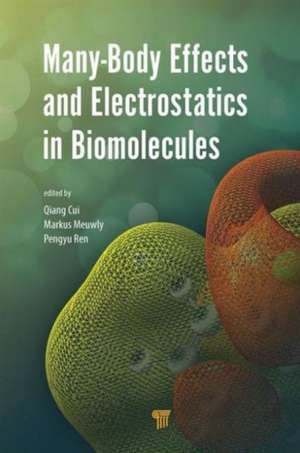Many-Body Effects and Electrostatics in Biomolecules
Editat de Qiang Cui, Markus Meuwly, Pengyu Renen Limba Engleză Hardback – 14 mar 2016
Preț: 1024.29 lei
Preț vechi: 1372.16 lei
-25% Nou
Puncte Express: 1536
Preț estimativ în valută:
196.02€ • 212.85$ • 164.66£
196.02€ • 212.85$ • 164.66£
Comandă specială
Livrare economică 02-16 aprilie
Doresc să fiu notificat când acest titlu va fi disponibil:
Se trimite...
Preluare comenzi: 021 569.72.76
Specificații
ISBN-13: 9789814613927
ISBN-10: 9814613924
Pagini: 596
Ilustrații: 84
Dimensiuni: 152 x 229 mm
Greutate: 0.98 kg
Ediția:1
Editura: Jenny Stanford Publishing
Colecția Jenny Stanford Publishing
ISBN-10: 9814613924
Pagini: 596
Ilustrații: 84
Dimensiuni: 152 x 229 mm
Greutate: 0.98 kg
Ediția:1
Editura: Jenny Stanford Publishing
Colecția Jenny Stanford Publishing
Public țintă
Academic and PostgraduateCuprins
QM and QM/MM Methods. Polarizable continuum models for (bio)molecular electrostatics: Basic theory and recent developments for macromolecules and simulations. A modified divide-and-conquer linear-scaling quantum force field with multipolar charge densities. Explicit polarization theory. Effective fragment potential method. Quantum mechanical methods for quantifying and analyzing non-covalent interactions and for force-field development. Force field development with density-based energy decomposition analysis. Atomistic Models. Differential geometry-based solvation and electrolyte transport models for biomolecular modeling: a review. Explicit inclusion of induced polarization in atomistic force fields based on the classical Drude oscillator model. Multipolar force fields for atomistic simulations. Quantum mechanics based polarizable force field for proteins. Status of the Gaussian electrostatic model, a density-based polarizable force field. Water models: Looking forward by looking backward. Coarse-Grained Models. A physics-based coarse-grained model with electric multipoles. Coarse-grained membrane force field based on Gay–Berne potential and electric multipoles. Perspectives on the coarse-grained models of DNA. RNA coarse-grained model theory.
Recenzii
"This book is a state-of-the-art report on the description of molecular energetics using force fields, which are the most critical element in computer simulations of biomolecular systems. The 16 chapters, written by leaders in the field, provide in-depth reports on all important current issues, including the representation of polarization, quantum mechanics-based force fields, and coarse-grained approaches for RNA, DNA, and membranes. This is an important reference for anyone involved in computational studies in chemistry and biology, especially those who want a deeper understanding of the underlying representations of intra- and intermolecular energetics."
—Prof. William L. Jorgensen, Yale University, USA
—Prof. William L. Jorgensen, Yale University, USA
Notă biografică
Qiang Cui is professor of chemistry at the University of Wisconsin-Madison, USA. He is interested in developing theoretical/computational methods for the analysis of biomolecular systems, especially concerning chemical reactions in enzymes, energy transduction in biomolecular machines, and, more recently, interaction between biomolecules, lipids, and inorganic materials.
Markus Meuwly is professor of physical and computational chemistry at the Department of Chemistry of the University of Basel and adjunct research professor at Brown University, USA. He is interested in developing computational/theoretical methods for quantitative atomistic simulations, specifically multipolar force fields and reactive processes in complex systems.
Markus Meuwly is professor of physical and computational chemistry at the Department of Chemistry of the University of Basel and adjunct research professor at Brown University, USA. He is interested in developing computational/theoretical methods for quantitative atomistic simulations, specifically multipolar force fields and reactive processes in complex systems.
Descriere
An important challenge that the field faces is to develop the next generation of computational models that strike the proper balance of computational efficiency and accuracy, so that problems of increasing complexity can be tackled in a systematic, robust manner. With contributions by leading experts in the area of biomolecular simulations, this book discusses cutting-edge ideas regarding effective strategies to describe many-body effects and electrostatics at quantum, classical, and coarse-grained levels. It not only provides an up-to-date snapshot of the current simulation field but also stimulates exchange of ideas across different sub-fields of modern computational (bio)chemistry.
